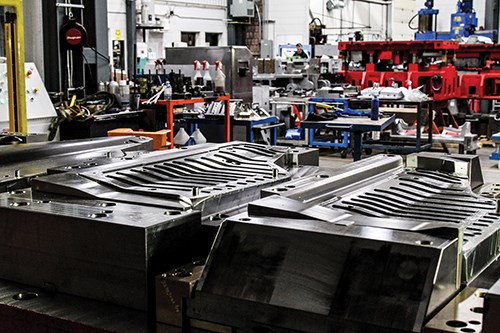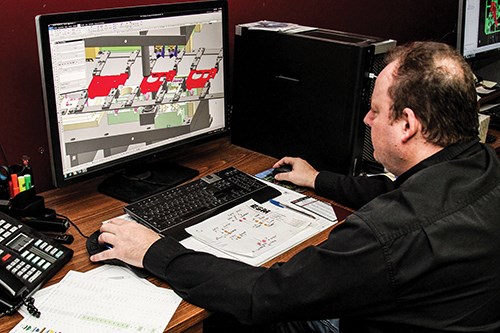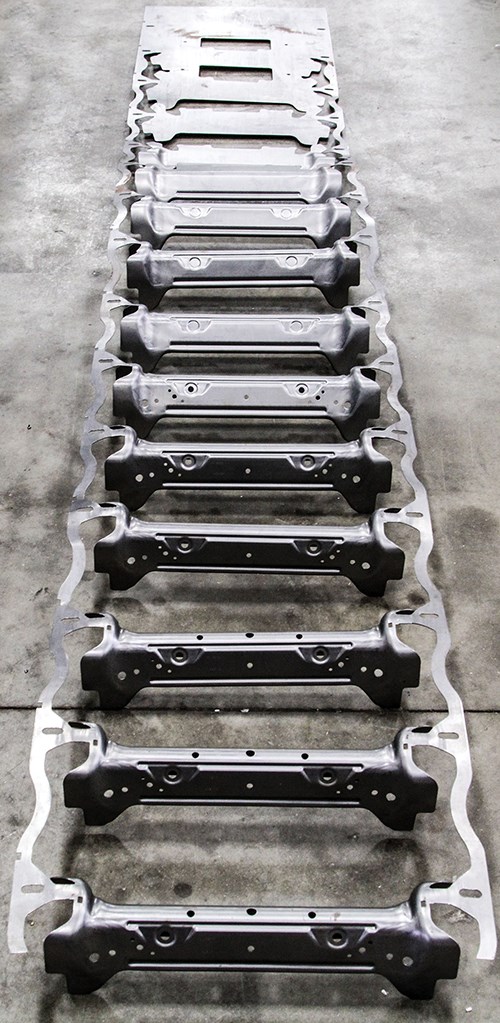CAM Software Is Key to Continuous Improvement
Armo Tool used NX CAM from Siemens PLM Software, along with new fixturing technology and CNC machines, to increase overall productivity by 40 percent.
Share






Hwacheon Machinery America, Inc.
Featured Content
View More.png;maxWidth=45)
DMG MORI - Cincinnati
Featured Content
View More

ECi Software Solutions, Inc.
Featured Content
View More
Continuous improvement efforts can lead to increased productivity and company competitiveness, along with a host of other benefits. Yet, what does continuous improvement actually look like?
For Armo-Tool Limited (London, Ontario, Canada), continuous improvement involved examining its computer-aided manufacturing (CAM) environment, identifying its weaknesses and finding solutions. During this process, the company found that it was difficult to simultaneously work with both 2D and 3D files as well as open all files without translation. By implementing NX CAM from Siemens PLM Software (Plano, Texas), along with new fixturing technology and CNC machines, the company increased overall productivity by 40 percent.
Armo Tool was founded more than 40 years ago as a precision grinding and coating shop that quickly grew as a manufacturer of progressive and transfer stamping dies and a provider of complex tooling and automation, particularly for the automotive industry. The company has used NX CAD software from Siemens PLM for die design for a number of years to ensure the minimum number of stations is used to make each part and to keep tooling costs down, says President Ben Whitney.
When the company began examining its CAM environment, it discovered a number of limitations with its previous CAM software, especially when attempting to program complex geometry or when working with both 2D and 3D CAD files. For instance, maintaining two tool libraries—one for 2D and one for 3D—was becoming very difficult, says Jozef Mucha, CAM program leader. There were also issues with specifying proper geometry for components developed and provided by the customer.
Armo Tool decided to implement NX CAM to take advantage of solids-based programming. Switching to NX CAM solved a lot of issues the company experienced with the previous CAM system, Mr. Mucha says. For instance, the NX tool library isn’t stored by the user or computer, but rather a network, so it is much easier to maintain. If the programming team decides to change the speeds and feeds for a particular cutter, they are changed team-wide.
“Using NX, we can accomplish anything we want to do,” Mr. Mucha says. “In addition, NX gives us exposure to continuous, stable five-axis machining.”
Because Armo Tool had used NX CAD for many years, NX CAM was a natural fit. It also enabled the data to be used without being translated—a really strong selling point for the company, Mr. Whitney says. Now, the automation side of the business can design in SolidWorks and NX CAM can open the files without the need for translation. NX CAM has been beneficial even for the segment of Armo Tool that wasn’t designed using NX CAD, he says.
When Armo Tool decided to purchase NX CAM, feature-based modeling was one of the main factors driving the decision. Longterm Technology Services Inc., a Siemens PLM Software partner, conducted a two-day training class specifically addressing this functionality. According to Mr. Mucha, the one-on-one session used customized training materials tailored to Armo Tool’s data, which helped employees quickly take full advantage of NX CAM. In fact, Mr. Mucha says the company is now starting to more fully use the latest capabilities for NX for competitive gain.
Mr. Whitney says that without changing CAD procedures, the feature-based capabilities of NX CAM recognizes about 90 percent of existing model features. He predicts that once the company is able to use the full capabilities of NX CAM, it’ll realize substantial operational efficiencies.
In particular, NX CAM has helped Armo Tool effectively set up a tombstone operation with different kinds of blocks using a 3D model. This wasn’t possible with the company’s prior CAM system. Complex setups require different blocks set up on one mill, all at the same time.
“You have to be very careful not to crash the spindle into block two when it’s going around block one,” Mr. Whitney says. “With NX CAM, we can readily perform the more rigorous 3D modeling that we’re setting up. We’ve been quite productive when doing that type of machining.”
When it comes to this sort of complex programming, the company can program four or five components in one session. With other software, that would be very difficult, Mr. Mucha says. Now, the company can simulate everything it cuts, all residing in one assembly. Armo Tool can see how components interact while the software does a gouge check on one component against adjacent components. By keeping the spindle running longer during operations, Arno Tool has increased productivity. Also, being able to assemble components into a cube for horizontal machining using NX CAM was a huge bonus for the company, Mr. Mucha says.
After implementing new fixturing technology, new CNC machines and new NX CAM software, Armo Tool says it has seen a 40 percent increase in productivity. The company continues to increase its strengths with the expanded use of NX, including bolstering its stamping design operations and taking on new, larger and more complex 3D forms. Armo Tool is now machining cast forms that are more than 50 inches long, with the ability to machine forms ranging to 50 by 80 inches and 3D plates much bigger than that.
“Our power, in terms of speed, quality and competitiveness with which we can do large forms has really grown over the last year,” Mr. Whitney says. For some companies, machining is how they get work. For us, it has always been design and innovation that largely drives new business. We’ve always had a first-class deliverable. Now with NX, we’ve moved into the domain of world-class CNC machining,” he says.
Related Content
Automated CAM Programming – Is Your Software Really Delivering?
A look at the latest automation tools in Autodesk Fusion 360 software and how forward-thinking machine shops and manufacturing departments are using them to slash delivery times and win more business.
Read MoreGenerating a Digital Twin in the CNC
New control technology captures critical data about a machining process and uses it to create a 3D graphical representation of the finished workpiece. This new type of digital twin helps relate machining results to machine performance, leading to better decisions on the shop floor.
Read MoreCutting Part Programming Times Through AI
CAM Assist cuts repetition from part programming — early users say it cuts tribal knowledge and could be a useful tool for training new programmers.
Read MoreThe Power of Practical Demonstrations and Projects
Practical work has served Bridgerland Technical College both in preparing its current students for manufacturing jobs and in appealing to new generations of potential machinists.
Read MoreRead Next
Registration Now Open for the Precision Machining Technology Show (PMTS) 2025
The precision machining industry’s premier event returns to Cleveland, OH, April 1-3.
Read More5 Rules of Thumb for Buying CNC Machine Tools
Use these tips to carefully plan your machine tool purchases and to avoid regretting your decision later.
Read MoreBuilding Out a Foundation for Student Machinists
Autodesk and Haas have teamed up to produce an introductory course for students that covers the basics of CAD, CAM and CNC while providing them with a portfolio part.
Read More


































.jpg;maxWidth=300;quality=90)

.jpg;maxWidth=300;quality=90)














